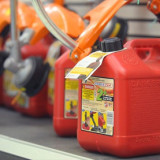Gas Cans Pose Severe Burn Injury Risk
According to the Consumer Product Safety Commission, at least 11 deaths and 1,200 emergency room injuries were caused by gas can explosions since 1998. Each of these reports involved explosions while gasoline was being poured from a red, plastic gasoline container. Despite the explosion and burn injury risk associated with plastic gas cans, roughly 100 million are in circulation around the United States.
Gas Can Flashback Explosions
The type of explosion occurring within these gas cans is known as a “flashback explosion.” These explosions occur under specific chemical conditions. Scientific testing conducted at the combustion lab at Worcester Polytechnic Institute confirms the flashback explosion theory.
How a Flashback Works
During a flashback explosion, gas vapor escapes a can containing a small amount of gasoline. If this escaped gas comes in contact with a spark or flame, it can ignite. After the initial ignition, the gas can “flash back” into the can. If the gas inside the can is composed of a certain concentration, it can ignite as well. This can lead to a flame explosion with potentially catastrophic results.
Gas Can Explosion Injuries
In 2010, Robert Jacoby suffered severe gas can explosion burns on more than 75 percent of his body. He accrued $1.5 million in medical costs after four months of burn unit hospitalization and several skin grafts and surgeries. Jacoby claims that there was no source of flame at the time of the explosion. This claim was confirmed by a fire investigator during the investigation of Jacoby’s lawsuit against the can’s manufacturer Blitz.
Gas Can Explosion Death
In 2010, 19-year-old Dylan Kornegay died after an infection resulting from third and fourth degree burns. The gas can Kornegay was holding exploded near his leg shortly after he used the can to pour gasoline to start a bonfire. The resulting burns covered more than 80 percent of his body. During his six-week stay at a burn center, Kornegay underwent 15 surgeries, including a partial leg amputation.
Defective Gas Can Lawsuits
During the past two decades, more than 80 lawsuits were filed against gas can manufacturers in the United States. These product liability lawsuits allege that the gas cans are defective in design due to the lack of a flame arrester. A flame arrester is a small piece of mesh or perforated disk designed to disrupt flame. Flame arresters are currently included in products such as metal “safety” gas cans and fuel tanks. Fuel arresters are also featured in other flammable liquid storage containers, including rum and charcoal lighter fluid.














